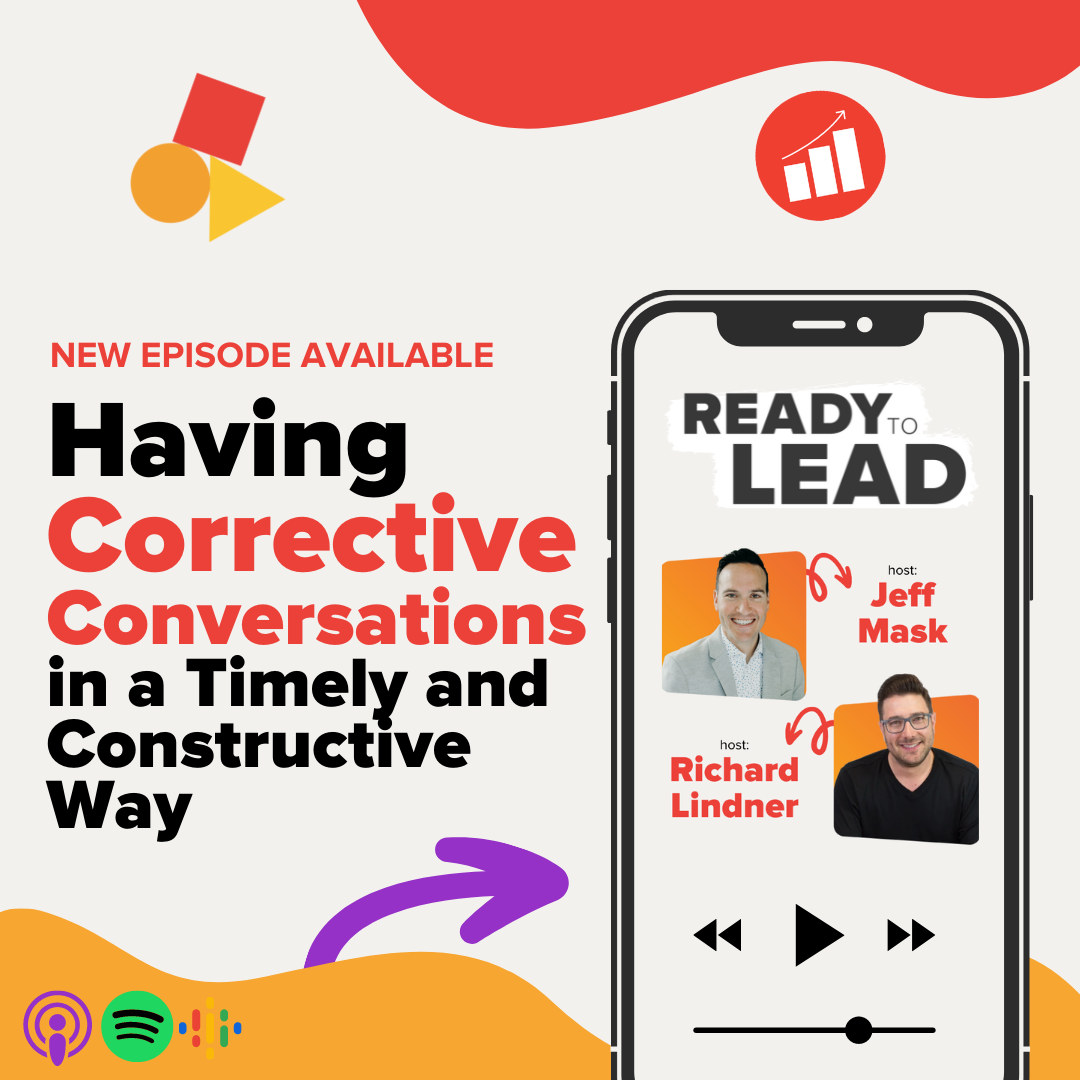Corrective conversations are never fun, but as leaders, it’s our responsibility to help people become better versions of themselves.
Today’s episode with co-hosts Richard Lindner and Jeff Mask is all about having those difficult, but necessary, corrective conversations. How do you give correction? When do you give it? How do you do it well? It can be an easy thing to mess up, and Jeff and Richard want to help people avoid that pain.
Listen in as they talk about why correction matters and how to do it in a way that truly benefits everyone.
WHY Have Corrective Conversations?
Why is it so important for leaders to give timely correction when something gets off track? The biggest reason is this: we need to lead people for who they can become, not for who they are today. We want the people we lead to become their best selves, and a lot of everyday actions prohibit them (and us) from doing that.
Jeff says that, as leaders, we have the ability to change the trajectory of ourselves and those we lead. When we don’t give that feedback, we’re not helping people see the implications of their behavior so they can be better. It’s an obligation, an opportunity, a blessing, to help people elevate their thinking and behavior. When we don’t, we’re just thinking about ourselves.
Richard says that the hardest pivot for him was changing the way he thought about correction. It doesn’t have to mean confrontation. Correction isn’t necessarily coming from a place of judgment. It doesn’t mean the person is bad. There’s just an action that needs changing. It’s pain avoidance when we don’t have these corrective conversations. We like to lie to ourselves and think we’re protecting the other person from pain, but we’re protecting ourselves.
WHEN to Have Corrective Conversations
Jeff once had a team member whose behavior was not in line with their core values. It wasn’t off-the-charts horrible, but he knew he needed to talk to this person and kept putting it off. His delay resulted in a chain of events that occurred in a short period of time that was very destructive to the brand of their company and the overall vibe of their team. It got out of hand quickly because Jeff didn’t have the courage to address it at that moment.
If something strikes you as off on your core values, that’s your first and clearest red flag. Core values can be a guiding light for how to behave. Maybe you have that spidey sense that something is odd or a little uncomfortable—or you notice a reaction or body language from the person that person is talking to. In a virtual world, this can be more difficult. Don’t avoid it and let it grow into a larger problem down the road.
Richard always looks at attitude, effort, and effectiveness. Those are the categories he puts things in when evaluating each team member. If something is off in any of these categories, then a conversation is needed. Attitude and effort are more of a corrective conversation. Effectiveness is more of an exploratory conversation.
Jeff says that Richard married data and intuition. Data can be taught; intuition can’t be. Going down the intuitive path (spidey sense) isn’t helpful if there’s only an intangible aspect. You need intuition + data.
Definitely don’t wait until the time is right, because it never will be. Don’t wait until your next one on one. The more time that goes by without correction, the more it communicates that the behavior is acceptable. This is how a good work culture deteriorates.
Have the conversation that same day—with one caveat. If there’s a blow-up and someone loses their cool, that needs to be dealt with, but there needs to be a cooling off period. The deeper question is: how do we know if we are calm enough as a leader to offer the correction? If my motive to correct is in love and care for the person, I know I’m ready.
- Cool down.
- Get your mindset right.
- The outcome of the correction will be vastly different.
Learn to give the benefit of the doubt. Fight the urge to go to the worst story. What’s the best possible version? Come from a place of curiosity. What do you need to do to break you from that triggering place and help you calm down? Jumping jacks? Rehearse Ted Lasso quotes? Take a walk?
WHERE to Have Corrective Conversations
You’ve heard the phrase “praise in public, correct in private,” right? For the most part, Jeff likes that statement, but with caveats. If you’re leading a leadership team, and there’s a behavior that’s off, hopefully you have enough trust within the team to address it at the moment. You can say something like: “This isn’t how we roll. We hold ourselves to a higher standard.” When you don’t correct in public, you’ve communicated that it’s tolerated. Or, worst case, “ah, there’s the leader’s favorite.”
Jeff shared a story of a time he was meeting with a team doing annual planning. It was all about creating a future you don’t know exists yet. People’s livelihoods were on the line. The energy from one team member was very negative (“this is why it can’t be done”). Jeff is a fan of constructive criticism, but he’s not a fan of looking for all the reasons “why not,” and sucking all the life out of a room.
It was the middle of day one of a two-day meeting, and Jeff told the guy in front of the rest of the team, “You know I love you, so before I say anything, I need you to know that. Everything coming out of your mouth is why things can’t happen. I need your help to change it from why it can’t to what needs to be in place for it to happen. Sometimes you act like a victim, and I need you to be the champion you are.”
He looked at Jeff, and the rest of the team looked at Jeff, but Jeff knew he had done what he needed to do. The whole energy for the year they were creating was getting destroyed by one negative person. That happened 10 years ago, and 3 different times that guy has told Jeff that that one conversation was more pivotal than any other conversation in his career. “When you called me a victim in front of everybody else, at first I was pissed,” he said. “But I knew you were right, and I had a choice to make. I had to change.”
HOW to Have Corrective Conversations
All of this leads to HOW. How do we have a corrective conversation that leads to the desired outcome of growth, change, and alignment?
First, how NOT to: don’t use a medium that’s not open to corrective conversation. Not Slack, text, or email. This needs to be done over Zoom or in person. Don’t start it with written communication. It feels efficient, but don’t do it. It doesn’t end well 99.99% of the time. The intent isn’t understood. It’s more judging than curious. We’re missing out on the richness of nonverbal communication. The person will read the written text through the tone of what they’re feeling, like we all do.
Remember, from the book, Fierce Conversations—I want to talk with you, not I need to talk to you. Want and with, not need and to. Start with that, pull them aside, and say, “let’s chat for 15 minutes.” When your motive is love and care, the energy will be so different. When you’re annoyed and want to stick it to them, they know it.
Another tip: replace “but” with “and.” Don’t say a bunch of good stuff about them, then say “but.” Say the good stuff, and use “and.” I know you’re kind and good AND I think there’s a problem with x. Then ask inquisitive, thoughtful, inspiring questions. Not incriminating and condescending. “Hey, I saw this happen, and I’m curious, how did that occur to you?” At the very beginning, seek to understand their point of view. “What were you feeling when this happened?” is sooo much better than “what were you thinking?” Richard likes to ask: “What were you reacting to?”
Repeat what they just said, using slightly different wording. “What I hear you saying is ________.” And then the next question is the pivot. “So how do you think it occurred to the other person in the situation?” If you start with them, they won’t react with self-preservation. They’ll feel safe and can access that higher level of thinking. They can empathize with the other person. Then you can tell them how it occurred to you.
- How did it occur to you? What were you feeling? What were you reacting to?
- How do you think it occurred to [the other person]?
- This is how it occurred to me.
Key Takeaways
What are we doing as leaders? We’re inviting people to change their behavior for the good. We’re not forcing, pushing, or requiring. Inspire, not require. Inspiration comes through thoughtful, well-worded questions. When they see in you the passion for them to become better, they can’t help but become better. They’ll rise to the occasion.
Richard suggests a why, why, how sequence:
- Why is what happened detrimental?
- Why is the action going to keep you/the company from meeting goals?
- How are you going to get in alignment?
Last step: follow everything up with an email. “Thanks, Dan, for the conversation today. Just wanted to recap so we’re on the same page. Can you give me a quick reply to this email to confirm that you received it and agree?”
Hopefully you heard some actionable steps you can take. Put your own personal twist on it. You’ve got this.
Richard and Jeff want to hear from YOU. Was something in today’s episode a big aha moment for you? Anything you disagreed with? How do you handle corrective conversations as a leader? Email them here with your thoughts/questions: feedback@readytolead.com
RESOURCES:
- Fierce Conversations (book by Susan Scott)
OTHER SHOWS YOU MIGHT ENJOY:
- Business Lunch with Roland Frasier and Ryan Deiss
- Perpetual Traffic with Ralph Burns and Kasim Aslam
- DigitalMarketer Podcast with Mark de Grasse


